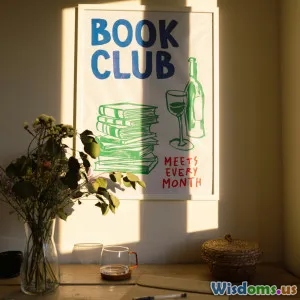
Self Publishing vs Traditional Publishing Which Is Right for You
8 min read Explore the pros and cons of self-publishing and traditional publishing to discover which path suits your book journey best. (0 Reviews)
Self Publishing vs Traditional Publishing: Which Is Right for You?
Publishing a book is a thrilling milestone—yet deciding how to bring your words into the world can be daunting. In an era where authors can choose between self-publishing and traditional publishing, understanding these paths is crucial. Each offers distinct opportunities and challenges. So how do you choose the best route for your literary dream?
Introduction
Imagine holding your published book in your hands. That moment signifies achievement, but understanding “how” to publish shapes your journey profoundly. Traditional avenues come with prestige and established structures, while self-publishing empowers unmatched independence. With the rise of digital platforms, self-publishing has exploded, giving authors new freedoms but also demanding new skills.
To make an informed choice, this article lays out detailed insights, real-world examples, and practical considerations to help you decide: Should you self-publish your book or pursue traditional publishing?
Understanding Traditional Publishing
What Is Traditional Publishing?
Traditional publishing involves partnering with established companies—publishers who curate, edit, design, market, and distribute your book. The process usually starts with querying literary agents or submitting manuscripts directly to publishers. If accepted, the publisher invests financial resources and expertise.
Advantages of Traditional Publishing
-
Professional Support: Publishers offer seasoned editors, designers, and marketers. For example, J.K. Rowling’s "Harry Potter" series was published by Bloomsbury, benefiting from their vast editorial and marketing resources.
-
Wider Distribution: Traditional presses have strong relationships with bookstores, libraries, and online retailers. This often results in better bookstore placement and global reach.
-
Prestige and Credibility: A traditional contract can boost your book’s credibility. Awards and reviews often target traditionally published works more readily.
-
Advances and Royalties: Many traditional publishers provide advances—upfront payments that can provide financial support while you write or promote your book.
Challenges in Traditional Publishing
-
Highly Competitive: Acceptance rates are low; notable authors often face years of rejection before acceptance.
-
Loss of Control: Publishers may change titles, covers, or edit content extensively.
-
Long Timelines: Traditional publishing can take 1-2 years from manuscript acceptance to release.
-
Lower Royalty Rates: Authors usually earn 10-15% royalties, sometimes less for certain formats.
The Rise of Self-Publishing
What Is Self-Publishing?
Self-publishing means taking full control of the publishing process. Authors handle or outsource editing, cover design, formatting, and marketing. Platforms like Amazon Kindle Direct Publishing (KDP), IngramSpark, and Smashwords have democratized this process.
Benefits of Self-Publishing
-
Creative Control: You choose content, covers, pricing, and marketing strategies. Andy Weir’s “The Martian” began as a self-published ebook and later sold millions, maintaining his creative vision.
-
Faster Time to Market: You can publish at any time without lengthy approval or gatekeepers.
-
Higher Royalties: Self-published authors can earn up to 70% royalties on ebooks.
-
Global Reach: Digital platforms reach countless readers worldwide instantly.
-
Niche Market Success: Self-publishing is perfect for niche genres underserved by traditional publishers.
Challenges of Self-Publishing
-
Significant Responsibility: All editing, design, and marketing fall on the author or hired professionals.
-
Financial Investment Upfront: You may need to pay for professional services.
-
Discoverability Issues: Without publisher marketing, gaining visibility can be difficult.
-
Perceptions and Stigma: While diminishing, some still view self-published works as lower quality.
Key Factors to Consider When Choosing
Your Goals as an Author
-
Desire for Control vs. Delegation: If you want full creative freedom, self-publishing excels. For mentorship and established support, traditional is ideal.
-
Timeline Urgency: Self-publishing offers speed; traditional takes patience.
-
Audience Reach: Traditional often penetrates brick-and-mortar stores more easily, but digital reach can be comparable.
Financial Considerations
-
Upfront Costs vs. Income: Traditional publishers cover costs but give smaller royalty cuts. Self-publishing requires investment but offers higher royalty percentages.
-
Long-Term Income: Self-published books can provide sustained passive income if marketed well.
Marketing Commitment
- Publisher Marketing vs. DIY: Traditional publishers have dedicated marketing teams, but you might still need to promote. Self-publishing demands strong personal marketing efforts.
Type of Book and Genre
Certain genres perform better in traditional routes (literary fiction, academic works) while others thrive in self-publishing (romance, sci-fi, self-help).
Real-World Success Stories
-
Traditional Success: Harper Lee’s "To Kill a Mockingbird" was famously published the conventional way, garnering literary acclaim and awards.
-
Self-Publishing Triumphs: Hugh Howey self-published "Wool," a dystopian sci-fi series, which caught the attention of major publishers later, illustrating hybrid success.
-
Hybrid Authors: Many authors now mix methods, starting independently, then gaining traditional contracts based on popularity.
Conclusion: Making the Right Choice for You
Both traditional and self-publishing offer viable, rewarding paths. Your choice hinges on your preferences for control, investment capacity, marketing willingness, and desired timeline. Consider your genre and long-term goals carefully.
If you crave prestige, long-term publisher backing, and expert support, traditional publishing might be your route. However, if you want speed, control, and the thrill of entrepreneurship, self-publishing invites you to be the captain of your own literary ship.
Whichever path you choose, creating a compelling, well-crafted book is paramount. As acclaimed author Neil Gaiman states, “Write the best book you can write and finish it.” The publishing model is just the vessel to deliver your story to readers around the world.
Embrace your publishing journey with clarity and confidence—you’re closer to inspiring readers than you might think.
References:
- Jane Friedman, The Business of Being a Writer
- Joanna Penn, How to Market a Book
- Amazon KDP Sales Data
- Author interviews and testimonials on publishing experiences
Rate the Post
User Reviews
Popular Posts





















